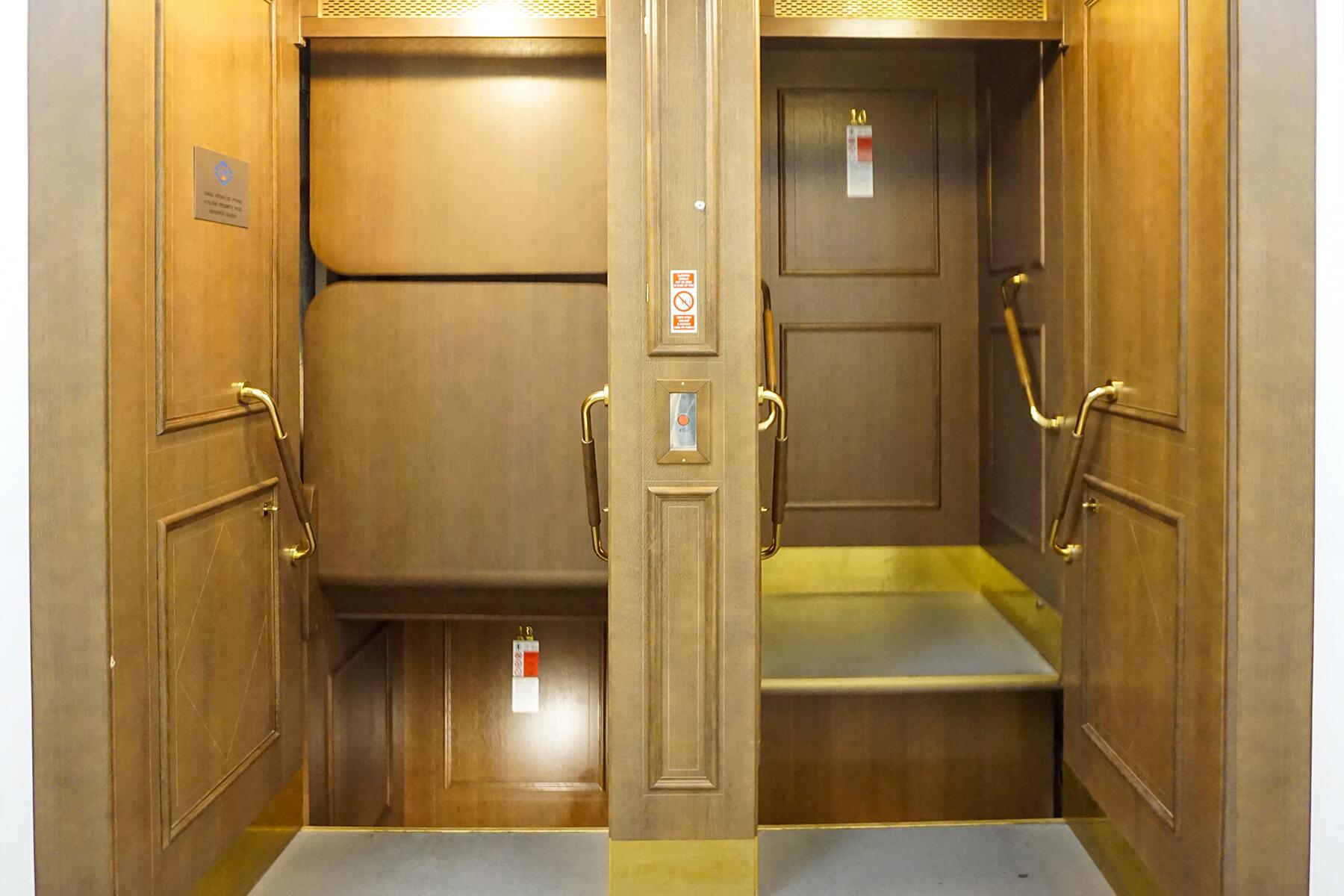Step right up for the paternoster grand tour. Quickly, now!
On a visit to Budapest, I stopped at a beautiful Art Deco office building designed by famed Hungarian architect Ödön Lechner, the Hungarian Gaudi. Now, usually, I’d have been happy enough just to look at the architectural wonder that is the building, snapping pictures of its tiled zoomorphic roof, but I’d been tipped off by my hotel concierge that what I should be looking for could be found inside: a paternoster.
The paternoster is a door-less elevator with two side-by-side shafts and two cars; simultaneously one goes up one side and the second down the other. You don’t push a button to call for the lift, the paternoster goes around in a continuous loop. Forever.
I’ve been obsessed with them ever since reading German writer Heinrich Böll’s short story Murke’s Collected Silences, then seeing them in a bunch of old movies: the 1948 movie Berlin Express, and the final scene of Doris Dörrie’s 1985 film Männer, as well as in the more recent Netflix series Babylon Berlin. This long-had fascination turns me into a kid at just the thought of riding one, so I have made a point to look for them when abroad.
The non-English-speaking receptionist at the Ödön building in Budapest could hardly make out what I was trying to ask (miming an up-and-down elevator is not so easy). But an English-speaking employee happened by and translated, helping me plead my case: Could I ride your paternoster? Their answer: no way. The receptionist did indulge me a little though and allowed me into the foyer to watch it in action. All I could do was the next best thing (or the very best thing for my Instagram): get the ultimate paternoster shot—a torso going up and the head of another person descending side-by-side.
Recommended Fodor’s Video
You don’t push a button to call for the lift, the paternoster goes around in a continuous loop.
In 1877, British engineer Peter Hart patented the paternoster. In 1884, the English engineering firm of J & E Hall installed one in a London office building. They soon swept through the UK and quickly became prevalent in offices, government buildings, universities, and hospitals across Europe. Paternosters were thought of as quite efficient because they could accommodate a continuous flow of people.
Indeed, an elevator that never stops moving and has no doors, which you jump onto and out of, does sound somewhat terrifying (some people have even called them Europe’s elevators of death). Paternosters are at times hazardous, causing several accidents (some fatal). Because of their lack of practicality (they are not wheelchair accessible and many accidents have occurred when people have tried to use them for things like trolleys or ladders), they’ve been largely phased out across Europe. Still, there are quite a few still around—and going around—if you know where to look.
In Helsinki, I had better luck than in Budapest actually riding a paternoster. A kind manager at the Stockmann department store let me ride the employee paternoster. She said they actually do allow customers, upon request, to give the elevator a try. I jumped in with some trepidation at first but soon felt just fine as it jerked and shook its way up. I was loving it, as it went from darkness to light between floors. The best part was the switch at the top and bottom floors when you ride sideways.
By the time I got to Stuttgart I was a paternoster pro. I made my way to the Rathaus (City Hall) in Stuttgart’s charming old town. Here, the paternoster was actually open to the public. I jumped on and took a few spins around.
It seems there are other fans in my milieu. A Canadian friend told me, “When I visited my Oma in Hamburg back in the ’70s, the Air Canada office was in a building with one of these. I am glad to see they still exist. The safety freaks would never allow them in North America.”
Well, European safety freaks have had their say, too. Not without cause: Between 1970 and 1993, five people were killed by paternosters, including a widely publicized paternoster accident at Newcastle University in the UK in 1989. The fatality caused an 18-month shut-down of all paternosters in the UK and an ongoing threat to do away with them all together. This, in turn, caused a wave a popular resistance.
The EU has banned building new ones, but some old ones are being restored, or outfitted with state-of-the-art safety devices and are thus allowed to remain in operation.
Despite dangers, few want to see these historic and, let’s face it, fun, lifts completely disappear. The EU has banned building new ones, but some old ones are being restored, or outfitted with state-of-the-art safety devices and are thus allowed to remain in operation. Case in point, in 2017, the rooftop-terrace on the beautiful art Nouveau Lucerna Palace concert venue in Prague was reopened. Accessing to the rooftop venue via the building’s historic paternoster, was a selling point. Prague is actually one of the great paternoster cities. You can find paternosters in the City Hall building and in Skoda Palace, at the YMCA Palace, and the Faculty of Law.
In Copenhagen, a paternoster at the Christiansborg Palace, which houses the Danish Parliament, has become an unexpected emblem of parliamentary democracy. Danish lawmakers are often photographed jumping in and out of the Paternoster when they want to reach the Parliament hall quickly to vote within the allotted time after the bell has sounded. Tragically, though, one of the most beautiful of Copenhagen’s Paternosters, a 1920s model in the Axelborg building, was the site of another fatal accident in 2012 when an 80-year-old man got caught in one.
Most paternoster scholars would say that Germans are the true heir to the Paternoster legacy. They are loopy for the lifts. By some estimates, there are still 200 in operation across the country (though not all are opened to the public). In Berlin, you can find them at the offices of the newspaper Neues Deutschland and the magazine Bild (though the latter is not open to the public.) The paternoster seen in Babylon Berlin is located at the Rathaus in the Schöneberg district of Berlin. In fact, the country’s romance with paternosters seems set to continue with a new generation.
When I visited the paternoster in Stuttgart’s city hall, a group of school kids was there too on a paternoster field trip. Their teacher was explaining the history of the lifts and the kids were then invited to jump in and try it. They were fearless and certainly seemed unfazed by the myth attributed to Charlie Chaplin that if you go onto a paternoster, you’ll come out on your head.



